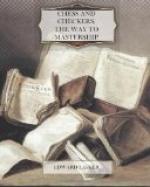The Bishop moves along an oblique line, that is, he may move to any square of the diagonals on which he stands unless—as in the case of the Rook—his way is obstructed by a man of his own color. If there is a hostile man in the way he may capture him. In Diagram 2, therefore, the Bishop may move to a2, b3, d5, e6 or, by capturing the Knight, to f7. He may not move, however, to g8, until his next move after capturing the Knight. In the other diagonal all squares, that is, fi, e2, d3, b5 and a6, are accessible to him.
As the Bishop is confined to squares of the same color as the one on which he stood at the beginning of the game he has access only to thirty-two squares of the board, and from this it is evident that the Rook to whom all squares of the board are accessible is a stronger man.
The Queen
The Queen has the power of both Rook and Bishop having the choice of moving to any square of the rank, file or diagonal on which she stands as long as her path is clear. In Diagram 2 the squares to which the Queen may move are, therefore, e3, b4, c5, e7, f8, f1, b5, C7, b8, d1, d2, d3, d4, ds, d7, d8, a6, b6, c6, e6, f6, g6 and h6. Like the Rook and Bishop she has the power of capturing a hostile man by occupying his square.
The Queen is by far the most powerful of the pieces. Later it will be seen that ordinarily her strength is about equal to the strength of two Rooks.
The King
The King, like the Queen, moves and captures in any direction, but he is much less powerful because he may move only one square at a time. Nevertheless, he is the most important man, for, as said at the beginning, the object of each side is the capture of the opposing King.
To save the King from untimely death there is a rule that the King may not move into any square which is in the direct range of any man of his enemy. Thus, in Diagram 2 the black King may move to f2, g2, h2, f3 and h3, but he may not move to f4 or g4 nor may he capture the Pawn on h4, for on any of these squares he could be captured by the white Rook.
The white King in Diagram 2 has only three squares to which he may go, namely, b1, b2 and c2, as the squares d1 and d2, though being in his range, are commanded by the black Queen.
The Knight
The Knight moves neither in rank nor file nor diagonal and, therefore, usually offers a little more difficulty to the beginner than the other pieces. The Knight’s move is perhaps best described as a leap to the next but one square of different color.[Footnote: It may be helpful to consider the Knight’s move when completed as having described a letter “L” composed of four squares, three in one direction and one at right angles to them.] For instance, in Diagram 2 the Knight may move to d8, d6, e5, g5, h6 and h8. In moving to d6 he would capture the Queen.




